The Federal Government and Early Elective Deliveries in Healthcare
VerifiedAdded on 2021/04/17
|6
|1591
|62
Essay
AI Summary
This essay examines the critical issue of early elective deliveries within the context of the U.S. healthcare system, highlighting the federal government's role in addressing the problem. The essay identifies the adverse consequences of these deliveries, including preventable harm to patients, unnecessary healthcare costs, and unreasonable incentives within the payment system. It emphasizes the recommendations of medical organizations against elective deliveries before 39 weeks of gestation, and analyzes the trends in the rate of such deliveries. The essay argues for the need for government intervention, suggesting measures like banning medicated payments for non-medically necessary early deliveries and promoting transparency to reduce mortality rates and improve healthcare outcomes. It also stresses the importance of collaboration between the government and the business community to address systemic healthcare issues.

Running head: FEDERAL GOVERNMENT
Federal Government
Name of the Student:
Name of the University:
Author note:
Federal Government
Name of the Student:
Name of the University:
Author note:
Paraphrase This Document
Need a fresh take? Get an instant paraphrase of this document with our AI Paraphraser
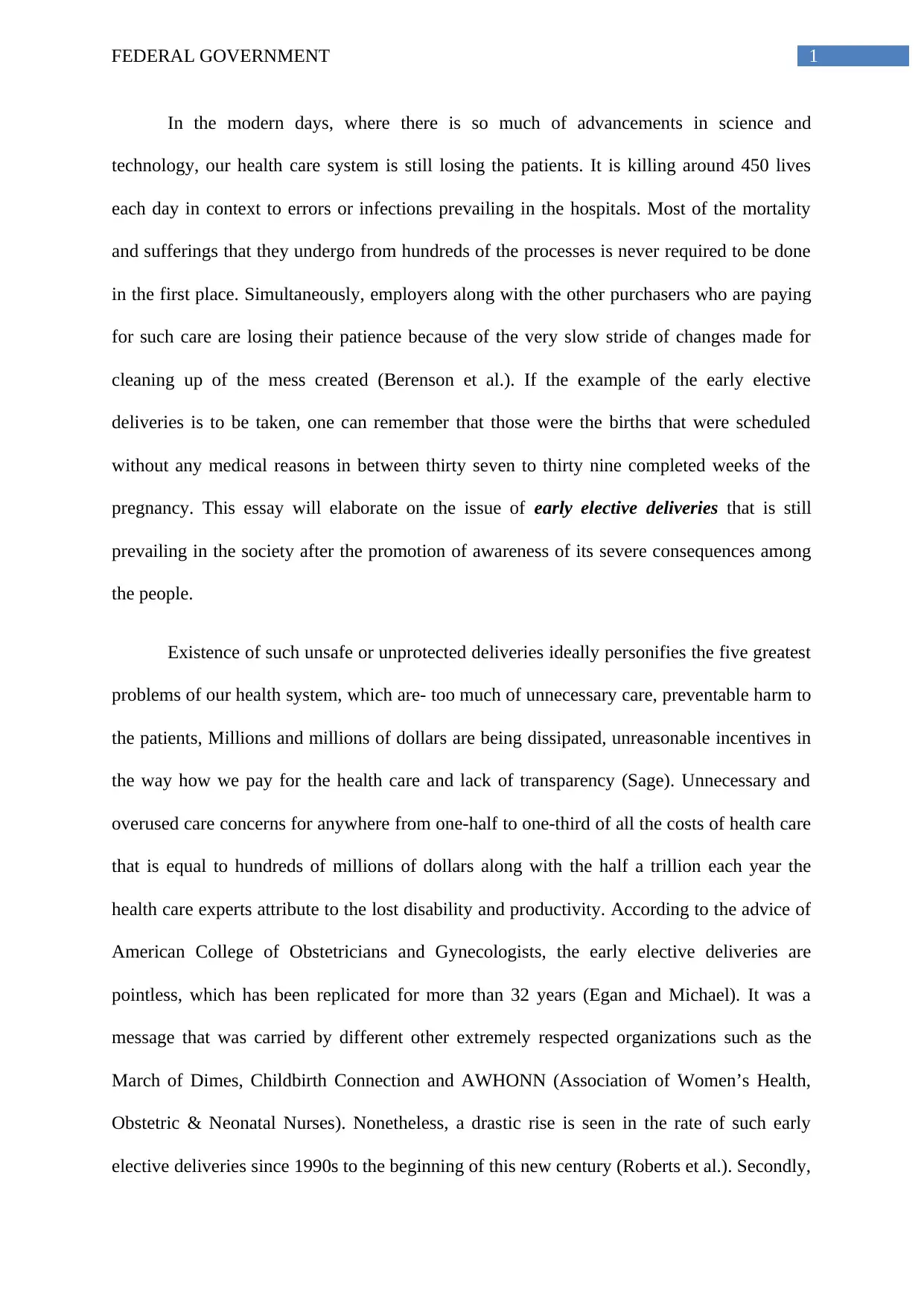
1FEDERAL GOVERNMENT
In the modern days, where there is so much of advancements in science and
technology, our health care system is still losing the patients. It is killing around 450 lives
each day in context to errors or infections prevailing in the hospitals. Most of the mortality
and sufferings that they undergo from hundreds of the processes is never required to be done
in the first place. Simultaneously, employers along with the other purchasers who are paying
for such care are losing their patience because of the very slow stride of changes made for
cleaning up of the mess created (Berenson et al.). If the example of the early elective
deliveries is to be taken, one can remember that those were the births that were scheduled
without any medical reasons in between thirty seven to thirty nine completed weeks of the
pregnancy. This essay will elaborate on the issue of early elective deliveries that is still
prevailing in the society after the promotion of awareness of its severe consequences among
the people.
Existence of such unsafe or unprotected deliveries ideally personifies the five greatest
problems of our health system, which are- too much of unnecessary care, preventable harm to
the patients, Millions and millions of dollars are being dissipated, unreasonable incentives in
the way how we pay for the health care and lack of transparency (Sage). Unnecessary and
overused care concerns for anywhere from one-half to one-third of all the costs of health care
that is equal to hundreds of millions of dollars along with the half a trillion each year the
health care experts attribute to the lost disability and productivity. According to the advice of
American College of Obstetricians and Gynecologists, the early elective deliveries are
pointless, which has been replicated for more than 32 years (Egan and Michael). It was a
message that was carried by different other extremely respected organizations such as the
March of Dimes, Childbirth Connection and AWHONN (Association of Women’s Health,
Obstetric & Neonatal Nurses). Nonetheless, a drastic rise is seen in the rate of such early
elective deliveries since 1990s to the beginning of this new century (Roberts et al.). Secondly,
In the modern days, where there is so much of advancements in science and
technology, our health care system is still losing the patients. It is killing around 450 lives
each day in context to errors or infections prevailing in the hospitals. Most of the mortality
and sufferings that they undergo from hundreds of the processes is never required to be done
in the first place. Simultaneously, employers along with the other purchasers who are paying
for such care are losing their patience because of the very slow stride of changes made for
cleaning up of the mess created (Berenson et al.). If the example of the early elective
deliveries is to be taken, one can remember that those were the births that were scheduled
without any medical reasons in between thirty seven to thirty nine completed weeks of the
pregnancy. This essay will elaborate on the issue of early elective deliveries that is still
prevailing in the society after the promotion of awareness of its severe consequences among
the people.
Existence of such unsafe or unprotected deliveries ideally personifies the five greatest
problems of our health system, which are- too much of unnecessary care, preventable harm to
the patients, Millions and millions of dollars are being dissipated, unreasonable incentives in
the way how we pay for the health care and lack of transparency (Sage). Unnecessary and
overused care concerns for anywhere from one-half to one-third of all the costs of health care
that is equal to hundreds of millions of dollars along with the half a trillion each year the
health care experts attribute to the lost disability and productivity. According to the advice of
American College of Obstetricians and Gynecologists, the early elective deliveries are
pointless, which has been replicated for more than 32 years (Egan and Michael). It was a
message that was carried by different other extremely respected organizations such as the
March of Dimes, Childbirth Connection and AWHONN (Association of Women’s Health,
Obstetric & Neonatal Nurses). Nonetheless, a drastic rise is seen in the rate of such early
elective deliveries since 1990s to the beginning of this new century (Roberts et al.). Secondly,
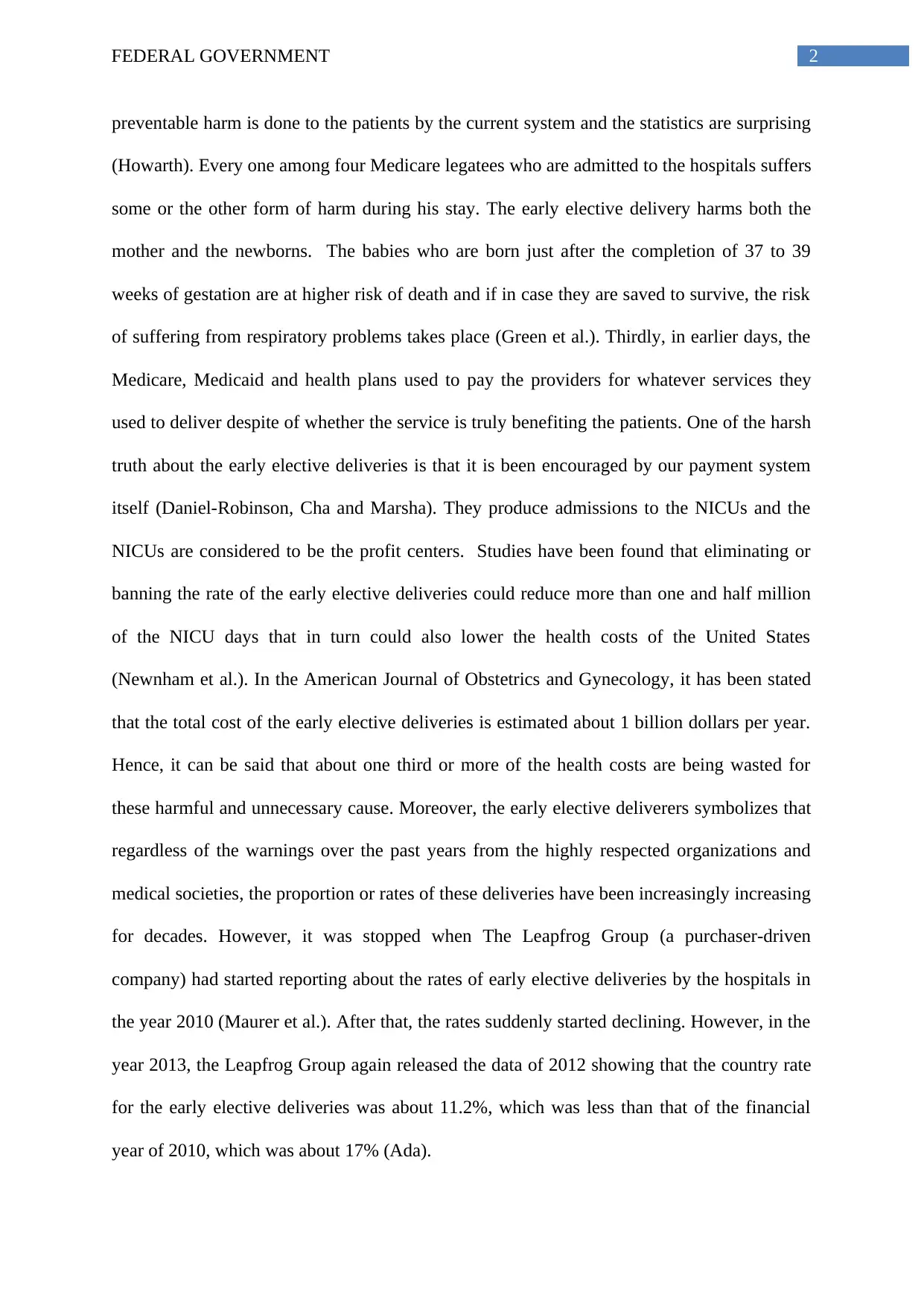
2FEDERAL GOVERNMENT
preventable harm is done to the patients by the current system and the statistics are surprising
(Howarth). Every one among four Medicare legatees who are admitted to the hospitals suffers
some or the other form of harm during his stay. The early elective delivery harms both the
mother and the newborns. The babies who are born just after the completion of 37 to 39
weeks of gestation are at higher risk of death and if in case they are saved to survive, the risk
of suffering from respiratory problems takes place (Green et al.). Thirdly, in earlier days, the
Medicare, Medicaid and health plans used to pay the providers for whatever services they
used to deliver despite of whether the service is truly benefiting the patients. One of the harsh
truth about the early elective deliveries is that it is been encouraged by our payment system
itself (Daniel-Robinson, Cha and Marsha). They produce admissions to the NICUs and the
NICUs are considered to be the profit centers. Studies have been found that eliminating or
banning the rate of the early elective deliveries could reduce more than one and half million
of the NICU days that in turn could also lower the health costs of the United States
(Newnham et al.). In the American Journal of Obstetrics and Gynecology, it has been stated
that the total cost of the early elective deliveries is estimated about 1 billion dollars per year.
Hence, it can be said that about one third or more of the health costs are being wasted for
these harmful and unnecessary cause. Moreover, the early elective deliverers symbolizes that
regardless of the warnings over the past years from the highly respected organizations and
medical societies, the proportion or rates of these deliveries have been increasingly increasing
for decades. However, it was stopped when The Leapfrog Group (a purchaser-driven
company) had started reporting about the rates of early elective deliveries by the hospitals in
the year 2010 (Maurer et al.). After that, the rates suddenly started declining. However, in the
year 2013, the Leapfrog Group again released the data of 2012 showing that the country rate
for the early elective deliveries was about 11.2%, which was less than that of the financial
year of 2010, which was about 17% (Ada).
preventable harm is done to the patients by the current system and the statistics are surprising
(Howarth). Every one among four Medicare legatees who are admitted to the hospitals suffers
some or the other form of harm during his stay. The early elective delivery harms both the
mother and the newborns. The babies who are born just after the completion of 37 to 39
weeks of gestation are at higher risk of death and if in case they are saved to survive, the risk
of suffering from respiratory problems takes place (Green et al.). Thirdly, in earlier days, the
Medicare, Medicaid and health plans used to pay the providers for whatever services they
used to deliver despite of whether the service is truly benefiting the patients. One of the harsh
truth about the early elective deliveries is that it is been encouraged by our payment system
itself (Daniel-Robinson, Cha and Marsha). They produce admissions to the NICUs and the
NICUs are considered to be the profit centers. Studies have been found that eliminating or
banning the rate of the early elective deliveries could reduce more than one and half million
of the NICU days that in turn could also lower the health costs of the United States
(Newnham et al.). In the American Journal of Obstetrics and Gynecology, it has been stated
that the total cost of the early elective deliveries is estimated about 1 billion dollars per year.
Hence, it can be said that about one third or more of the health costs are being wasted for
these harmful and unnecessary cause. Moreover, the early elective deliverers symbolizes that
regardless of the warnings over the past years from the highly respected organizations and
medical societies, the proportion or rates of these deliveries have been increasingly increasing
for decades. However, it was stopped when The Leapfrog Group (a purchaser-driven
company) had started reporting about the rates of early elective deliveries by the hospitals in
the year 2010 (Maurer et al.). After that, the rates suddenly started declining. However, in the
year 2013, the Leapfrog Group again released the data of 2012 showing that the country rate
for the early elective deliveries was about 11.2%, which was less than that of the financial
year of 2010, which was about 17% (Ada).
⊘ This is a preview!⊘
Do you want full access?
Subscribe today to unlock all pages.

Trusted by 1+ million students worldwide
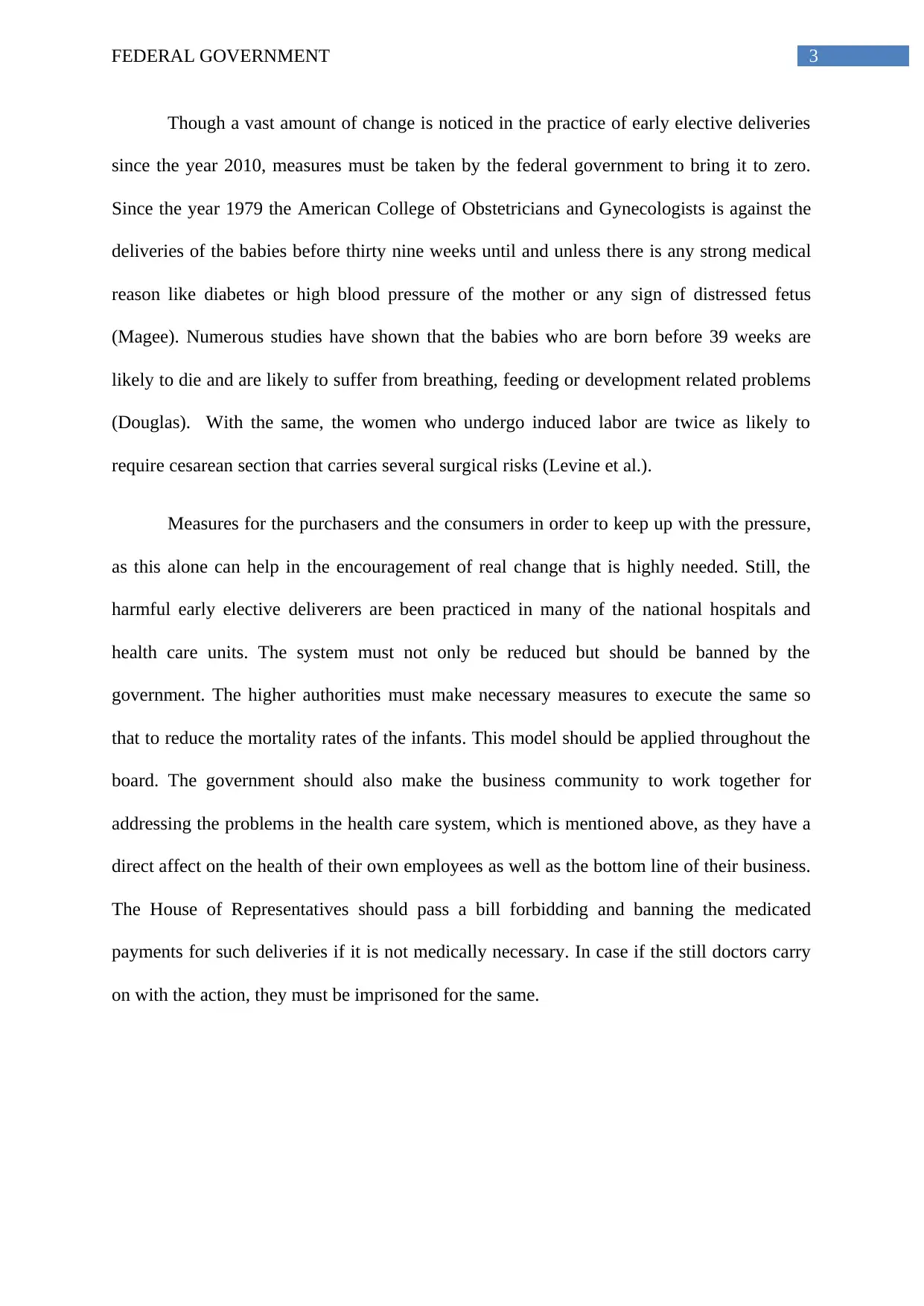
3FEDERAL GOVERNMENT
Though a vast amount of change is noticed in the practice of early elective deliveries
since the year 2010, measures must be taken by the federal government to bring it to zero.
Since the year 1979 the American College of Obstetricians and Gynecologists is against the
deliveries of the babies before thirty nine weeks until and unless there is any strong medical
reason like diabetes or high blood pressure of the mother or any sign of distressed fetus
(Magee). Numerous studies have shown that the babies who are born before 39 weeks are
likely to die and are likely to suffer from breathing, feeding or development related problems
(Douglas). With the same, the women who undergo induced labor are twice as likely to
require cesarean section that carries several surgical risks (Levine et al.).
Measures for the purchasers and the consumers in order to keep up with the pressure,
as this alone can help in the encouragement of real change that is highly needed. Still, the
harmful early elective deliverers are been practiced in many of the national hospitals and
health care units. The system must not only be reduced but should be banned by the
government. The higher authorities must make necessary measures to execute the same so
that to reduce the mortality rates of the infants. This model should be applied throughout the
board. The government should also make the business community to work together for
addressing the problems in the health care system, which is mentioned above, as they have a
direct affect on the health of their own employees as well as the bottom line of their business.
The House of Representatives should pass a bill forbidding and banning the medicated
payments for such deliveries if it is not medically necessary. In case if the still doctors carry
on with the action, they must be imprisoned for the same.
Though a vast amount of change is noticed in the practice of early elective deliveries
since the year 2010, measures must be taken by the federal government to bring it to zero.
Since the year 1979 the American College of Obstetricians and Gynecologists is against the
deliveries of the babies before thirty nine weeks until and unless there is any strong medical
reason like diabetes or high blood pressure of the mother or any sign of distressed fetus
(Magee). Numerous studies have shown that the babies who are born before 39 weeks are
likely to die and are likely to suffer from breathing, feeding or development related problems
(Douglas). With the same, the women who undergo induced labor are twice as likely to
require cesarean section that carries several surgical risks (Levine et al.).
Measures for the purchasers and the consumers in order to keep up with the pressure,
as this alone can help in the encouragement of real change that is highly needed. Still, the
harmful early elective deliverers are been practiced in many of the national hospitals and
health care units. The system must not only be reduced but should be banned by the
government. The higher authorities must make necessary measures to execute the same so
that to reduce the mortality rates of the infants. This model should be applied throughout the
board. The government should also make the business community to work together for
addressing the problems in the health care system, which is mentioned above, as they have a
direct affect on the health of their own employees as well as the bottom line of their business.
The House of Representatives should pass a bill forbidding and banning the medicated
payments for such deliveries if it is not medically necessary. In case if the still doctors carry
on with the action, they must be imprisoned for the same.
Paraphrase This Document
Need a fresh take? Get an instant paraphrase of this document with our AI Paraphraser
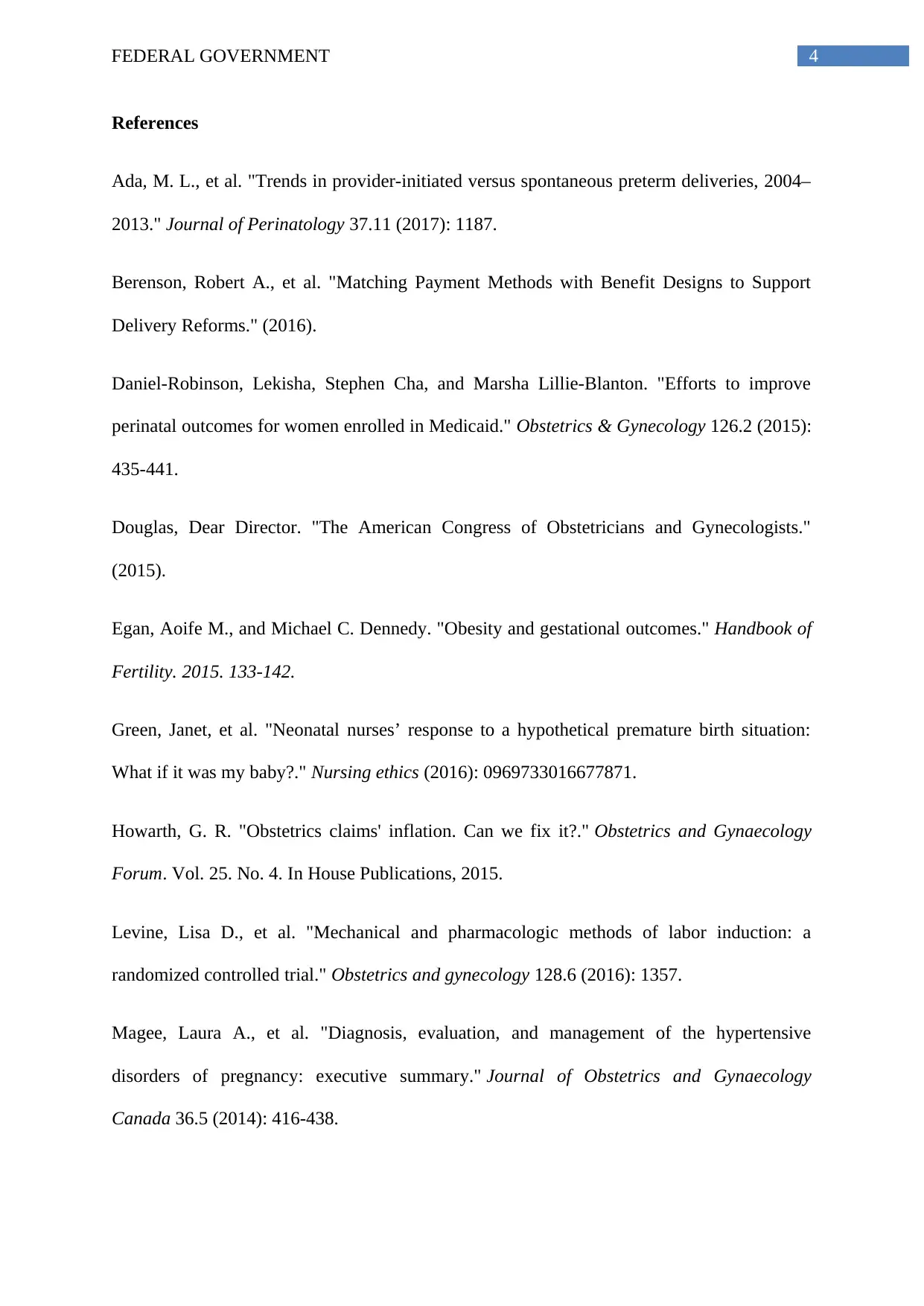
4FEDERAL GOVERNMENT
References
Ada, M. L., et al. "Trends in provider-initiated versus spontaneous preterm deliveries, 2004–
2013." Journal of Perinatology 37.11 (2017): 1187.
Berenson, Robert A., et al. "Matching Payment Methods with Benefit Designs to Support
Delivery Reforms." (2016).
Daniel-Robinson, Lekisha, Stephen Cha, and Marsha Lillie-Blanton. "Efforts to improve
perinatal outcomes for women enrolled in Medicaid." Obstetrics & Gynecology 126.2 (2015):
435-441.
Douglas, Dear Director. "The American Congress of Obstetricians and Gynecologists."
(2015).
Egan, Aoife M., and Michael C. Dennedy. "Obesity and gestational outcomes." Handbook of
Fertility. 2015. 133-142.
Green, Janet, et al. "Neonatal nurses’ response to a hypothetical premature birth situation:
What if it was my baby?." Nursing ethics (2016): 0969733016677871.
Howarth, G. R. "Obstetrics claims' inflation. Can we fix it?." Obstetrics and Gynaecology
Forum. Vol. 25. No. 4. In House Publications, 2015.
Levine, Lisa D., et al. "Mechanical and pharmacologic methods of labor induction: a
randomized controlled trial." Obstetrics and gynecology 128.6 (2016): 1357.
Magee, Laura A., et al. "Diagnosis, evaluation, and management of the hypertensive
disorders of pregnancy: executive summary." Journal of Obstetrics and Gynaecology
Canada 36.5 (2014): 416-438.
References
Ada, M. L., et al. "Trends in provider-initiated versus spontaneous preterm deliveries, 2004–
2013." Journal of Perinatology 37.11 (2017): 1187.
Berenson, Robert A., et al. "Matching Payment Methods with Benefit Designs to Support
Delivery Reforms." (2016).
Daniel-Robinson, Lekisha, Stephen Cha, and Marsha Lillie-Blanton. "Efforts to improve
perinatal outcomes for women enrolled in Medicaid." Obstetrics & Gynecology 126.2 (2015):
435-441.
Douglas, Dear Director. "The American Congress of Obstetricians and Gynecologists."
(2015).
Egan, Aoife M., and Michael C. Dennedy. "Obesity and gestational outcomes." Handbook of
Fertility. 2015. 133-142.
Green, Janet, et al. "Neonatal nurses’ response to a hypothetical premature birth situation:
What if it was my baby?." Nursing ethics (2016): 0969733016677871.
Howarth, G. R. "Obstetrics claims' inflation. Can we fix it?." Obstetrics and Gynaecology
Forum. Vol. 25. No. 4. In House Publications, 2015.
Levine, Lisa D., et al. "Mechanical and pharmacologic methods of labor induction: a
randomized controlled trial." Obstetrics and gynecology 128.6 (2016): 1357.
Magee, Laura A., et al. "Diagnosis, evaluation, and management of the hypertensive
disorders of pregnancy: executive summary." Journal of Obstetrics and Gynaecology
Canada 36.5 (2014): 416-438.
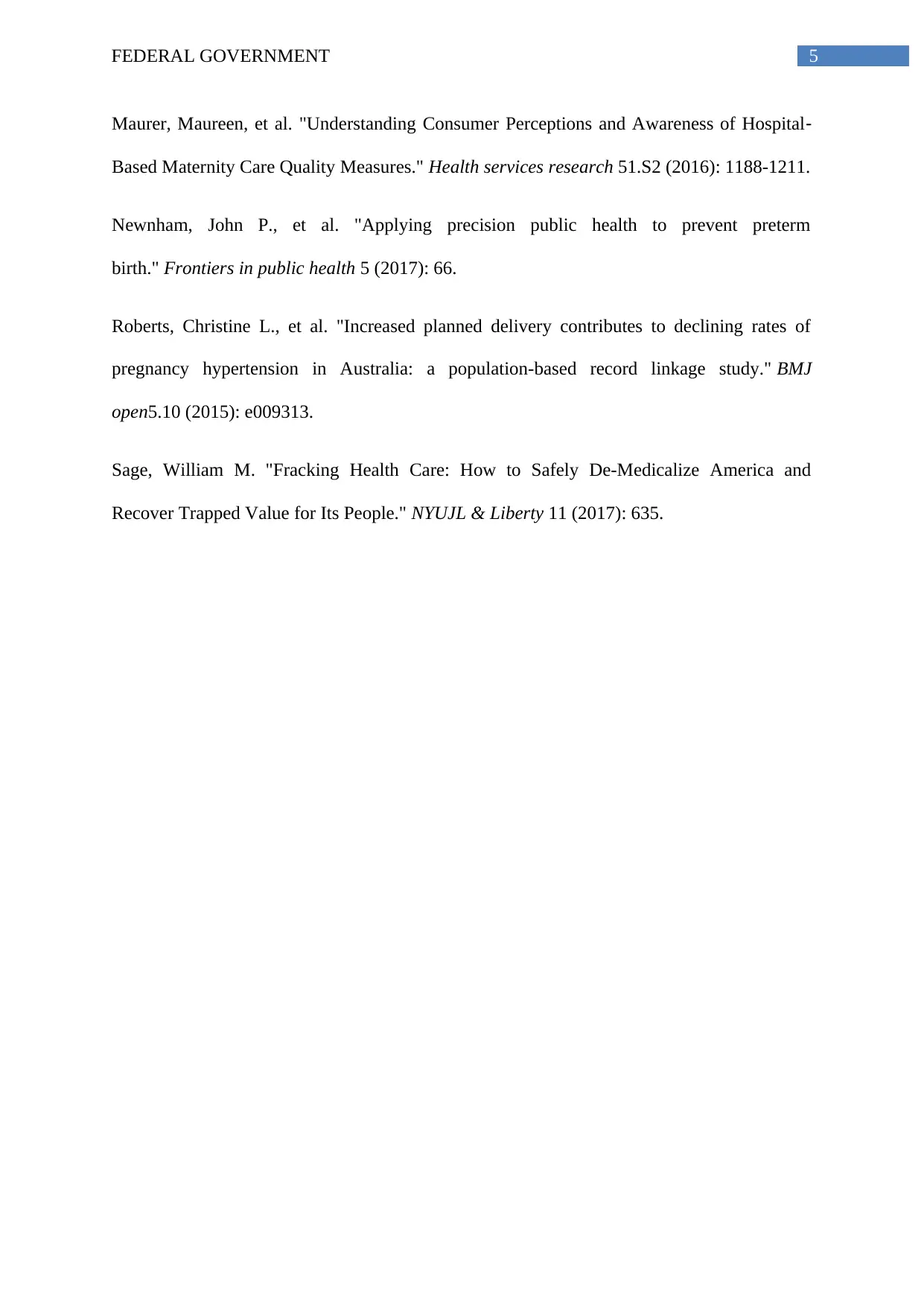
5FEDERAL GOVERNMENT
Maurer, Maureen, et al. "Understanding Consumer Perceptions and Awareness of Hospital‐
Based Maternity Care Quality Measures." Health services research 51.S2 (2016): 1188-1211.
Newnham, John P., et al. "Applying precision public health to prevent preterm
birth." Frontiers in public health 5 (2017): 66.
Roberts, Christine L., et al. "Increased planned delivery contributes to declining rates of
pregnancy hypertension in Australia: a population-based record linkage study." BMJ
open5.10 (2015): e009313.
Sage, William M. "Fracking Health Care: How to Safely De-Medicalize America and
Recover Trapped Value for Its People." NYUJL & Liberty 11 (2017): 635.
Maurer, Maureen, et al. "Understanding Consumer Perceptions and Awareness of Hospital‐
Based Maternity Care Quality Measures." Health services research 51.S2 (2016): 1188-1211.
Newnham, John P., et al. "Applying precision public health to prevent preterm
birth." Frontiers in public health 5 (2017): 66.
Roberts, Christine L., et al. "Increased planned delivery contributes to declining rates of
pregnancy hypertension in Australia: a population-based record linkage study." BMJ
open5.10 (2015): e009313.
Sage, William M. "Fracking Health Care: How to Safely De-Medicalize America and
Recover Trapped Value for Its People." NYUJL & Liberty 11 (2017): 635.
⊘ This is a preview!⊘
Do you want full access?
Subscribe today to unlock all pages.

Trusted by 1+ million students worldwide
1 out of 6
Your All-in-One AI-Powered Toolkit for Academic Success.
+13062052269
info@desklib.com
Available 24*7 on WhatsApp / Email
![[object Object]](/_next/static/media/star-bottom.7253800d.svg)
Unlock your academic potential
Copyright © 2020–2026 A2Z Services. All Rights Reserved. Developed and managed by ZUCOL.
